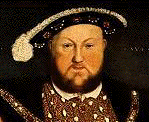Henry VIII and the break with Rome
The reformation of the church under Henry VIII was sparked both by personal desire* and by political concern* about the succession.
When Pope Clement VII refused to annul his marriage with Catherine of Aragon, Henry responded by enacting legislation which limited papal jurisdiction and revenues in England. In February of 1531 the Commons acknowledged the king as their "only and supreme lord and, as far as the law of Christ allows, even supreme head." In the Act of Supremacy* of 1534, the caveat "as far as the law of Christ allows" was deleted.
Henry's religious beliefs
Although Henry's reformation broke with the papacy, his own religious beliefs were orthodox, and the Church of England remained essentially Catholic in doctrine under his rule. He was not concerned with religion so much as power.
Henry VIII did not seek Protestant reform, but the abolition of papal jurisdiction inevitably encouraged the emergence of Protestant sympathizers. In 1539 Henry issued the Act of Six Articles, against those who advocated such Protestant reforms as marriage for the clergy or the denial of the doctrine of transubstantiation.
Footnotes
-
Henry's wives
Henry was in love with Anne Boleyn, and was deeply concerned because his wife, Catherine of Aragon had not borne him a living son. Henry's belief that he was being punished by God for his marriage to Catherine is discussed in the section on the historical background.
-
A tangled web
Henry had hoped to resolve the issue of who was to succeed him--and to expand the kingdom--by marrying his daughter, Mary, to the Holy Roman Emperor Charles V. However, although Henry supported Charles against France in 1521, Charles rejected an English alliance, breaking his engagement to Mary in order to marry Isabella of Portugal.
Henry therefore sought to dissolve his marriage to Catherine of Aragon to enable him to father a legitimate son in marriage to Anne Boleyn.
-
The Act of Supremacy
The Act of Supremacy established the crown as the "supreme head on earth" of the church. The establishment of royal supremacy put an end to conflicts between canon and civil law, making the sovereign's court the highest court of appeal for both secular and ecclesiastical courts.
It became treason to oppose Henry's title of "supreme head," one result of which was the execution of Sir Thomas More in July 1535.
